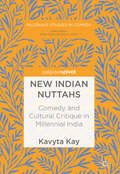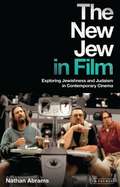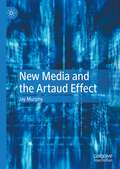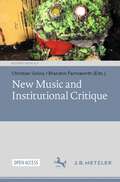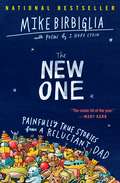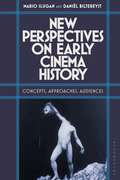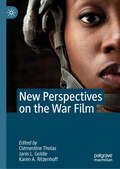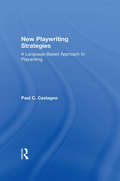- Table View
- List View
The New Hollywood Historical Film: 1967-78
by Tom SymmonsThe New Hollywood of the late 1960s and 1970s is among the most exciting and influential periods in the history of film. This book explores how the new wave of historical films were profoundly shaped by the controversies and concerns of the present.
New Hong Kong Cinema: Transitions to Becoming Chinese in 21st-Century East Asia
by Ruby CheungThe trajectory of Hong Kong films had been drastically affected long before the city’s official sovereignty transfer from the British to the Chinese in 1997. The change in course has become more visible in recent years as China has aggressively developed its national film industry and assumed the role of powerhouse in East Asia’s cinematic landscape. The author introduces the “Cinema of Transitions” to study the New Hong Kong Cinema and on- and off-screen life against this background. Using examples from the 1980s to the present, this book offers a fresh perspective on how Hong Kong-related Chinese-language films, filmmakers, audiences, and the workings of film business in East Asia have become major platforms on which “transitions” are negotiated.
The New Humor in the Progressive Era: Americanization and the Vaudeville Comedian (Palgrave Studies in Theatre and Performance History)
by R. DesRochersBy tracing the effects of unprecedented immigration, the advent of the new woman, and the little-known vaudeville careers of performers like the Elinore Sisters, Buster Keaton, and the Marx Brothers, DesRochers examines the relation between comedic vaudeville acts and progressive reformers as they fought over the new definition of "Americanness."
New Indian Nuttahs: Comedy and Cultural Critique in Millennial India (Palgrave Studies in Comedy)
by Kavyta KayThis book takes a journey into the new and exciting created by a the wave of Indian comedians today, described affectionately here as the New Indian Nuttahs, and looks at what these tell us about identity, “Indianness”, censorship, feminism, diaspora and millennial India. It provides a unique analysis into the growing phenomenon of internet comedy and into a dimension of Indian popular culture which has long been dominated by the traditional film and television industries. Through a mixture of close textual readings of online comedy videos and interviews with content creators and consumers in India, this book provides a fresh perspective on comedy studies in its approach to a global South context from a sociocultural perspective. As a protean form of new media, this has opened up new avenues of articulation, identification and disidentification and as such, this book makes a further contribution to South Asian, communication, media & cultural studies.
The New Jew in Film: Exploring Jewishness and Judaism in Contemporary Cinema
by Nathan AbramsJewish film characters have existed almost as long as the medium itself. But around 1990, films about Jews and their representation in cinema proliferated and took on new forms, marking a significant departure from the past. With a new generation of Jewish filmmakers, writers, actresses and actors at work, contemporary cinemas in Hollywood and the rest of the world have been depicting a multiplicity of new Jews, including tough Jews, brutish Jews, gay and lesbian Jews, Jewish cowboys, skinheads and superheroes, and Jews in space.The New Jew in Film is grounded in the study of over 300 films in Hollywood and beyond, including productions from Argentina, Australia, Canada, Germany, Hungary, Italy, Mexico, Russia, Spain, Sweden and the United Kingdom, as well as the United States and Israel. It explores these newand changing depictions of Jews, Jewishness and Judaism, providing a wider, more representative picture of the subject than has hitherto been attempted. This is a compelling, surprising and provocative book, whose chapters explore masculinity, femininity, sexuality, passivity, agency, religion, as well as new territory, including foodand bathrooms. Nathan Abrams's concern is to reveal how the representation of the Jew is used to convey confidence or anxieties about Jewish identity and history, as well as how it engages with questions of racial, sexual and gender politics. Inso doing, he also provides a welcome overview of important Jewish films produced globally over the last twenty years.
New Media: Theories and Practices of Digitextuality (AFI Film Readers)
by Anna Everett John T. CaldwellFirst published in 2003. Routledge is an imprint of Taylor & Francis, an informa company.
New Media: Theories and Practices of Digitextuality (AFI Film Readers)
by Anna Everett John T. CaldwellFirst published in 2003. Routledge is an imprint of Taylor & Francis, an informa company.
New Media and the Artaud Effect
by Jay MurphyThis book proposes, following Antonin Artaud, an investigation exploring the virtual body, neurology and the brain as fields of contestation, seeking a clearer understanding of Artaud's transformations that ultimately leads into examining the relevance Artaud may have for an adequate theory of the current media environment.New Media and the Artaud Effect is the only current full-length study of the relation of Artaud’s work to dilemmas of digital art, media and society today. It is also singular in that it combines a far-reaching discussion of the theoretical implications and ramifications of the ‘late’ or ‘final’ Artaud, with a treatment of individual media works, sometimes directly inspired from Artaud’s travails.Artaud has long been justly regarded as one of the seminal influences in mid- and late-20th century performance and theater: it is argued here that Artaud’s insights are if anything more applicable to digital/post-digital society and the plethora of works that are made possible by it.
New Media Dramaturgy: Performance, Media and New-Materialism (New Dramaturgies)
by Peter Eckersall Helena Grehan Edward ScheerThis book illuminates the shift in approaches to the uses of theatre and performance technology in the past twenty-five years and develops an account of new media dramaturgy (NMD), an approach to theatre informed by what the technology itself seems to want to say. Born of the synthesis of new media and new dramaturgy, NMD is practiced and performed in the work of a range of important artists from dumb type and their 1989 analog-industrial machine performance pH, to more recent examples from the work of Kris Verdonck and his A Two Dogs Company. Engaging with works from a range of artists and companies including: Blast Theory, Olafur Eliasson, Nakaya Fujiko and Janet Cardiff, we see a range of extruded performative technologies operating overtly on, with and against human bodies alongside more subtle dispersed, interactive and experiential media.
New Music and Institutional Critique (Ästhetiken X.0 – Zeitgenössische Konturen ästhetischen Denkens)
by Christian Grüny Brandon FarnsworthWhile institutional critique has long been an important part of artistic practice and theoretical debate in the visual arts, it has long escaped attention in the field of music. This open access volume assembles for the first time an array of theoretical approaches and practical examples dealing with New Music’s institutions, their critique, and their transformations. For scholars, leaders, and practitioners alike, it offers an important overview of current developments as well as theoretical reflections about New Music and its institutions today. In this way, it provides a major contribution to the debate about the present and future of contemporary music.
The New Neapolitan Cinema (Traditions in World Cinema)
by Alex Marlow-MannVito and the Others (1991), Death of a Neapolitan Mathematician (1992) and Libera (1993), the debuts of three young Neapolitan filmmakers, stood out dramatically from the landscape of Italian cinema in the early 1990s. On the back of their critical success, over the next decade and a half, Naples became a thriving centre for film production. In this first study in English of one of the most vital and stimulating currents in contemporary European Cinema, Alex Marlow-Mann provides a detailed, multi-faceted and provocative study of this distinct regional tradition. In tracing the movement's relationship with the popular musical melodramas previously produced in Naples, he reveals how contemporary Neapolitan filmmakers have interrogated, subverted and reconfigured cinematic convention as part of a through-going re-examination of Neapolitan identity. Key features include: analyses of over 45 contemporary Italian films, including Paolo Sorrentino's The Consequences of Love, Mario Martone's L'amore molesto, Antonio Capuano's Pianese Nunzio: 14 in May and Vincenzo Marra's Sailing Home; a theoretical discussion of the concept of regional cinema; an examination of the movement in its broader context as both product and critique of Mayor Bassolino's 'Neapolitan Renaissance'; and a study of one European film industry in terms of legislation, production, distribution and exhibition.
The New Neapolitan Cinema (Traditions in World Cinema)
by Alex Marlow-MannThe New Neapolitan Cinema provides close analysis of the whole of this movement, which stands as one of the most vital and stimulating currents in contemporary European Cinema.
New Nonfiction Film: Art, Poetics, and Documentary Theory
by Dara WaldronNew Nonfiction Film: Art, Poetics and Documentary Theory is the first book to offer a lengthy examination of the relationship between fiction and documentary from the perspective of art and poetics. The premise of the book is to propose a new category of nonfiction film that is distinguished from – as opposed to being conflated with – the documentary film in its multiple historical guises; a premise explored in case-studies of films by distinguished artists and filmmakers (Abbas Kiarostami, Ben Rivers, Chantal Akerman, Ben Russell Pat Collins and Gideon Koppel). The book builds a case for this new category of film, calling it the 'new nonfiction film,' and argues, in the process, that this kind of film works to dismantle the old distinctions between fiction and documentary film and therefore the axioms of Film and Cinema Studies as a discipline of study.
New Nonfiction Film: Art, Poetics, and Documentary Theory
by Dara WaldronNew Nonfiction Film: Art, Poetics and Documentary Theory is the first book to offer a lengthy examination of the relationship between fiction and documentary from the perspective of art and poetics. The premise of the book is to propose a new category of nonfiction film that is distinguished from – as opposed to being conflated with – the documentary film in its multiple historical guises; a premise explored in case-studies of films by distinguished artists and filmmakers (Abbas Kiarostami, Ben Rivers, Chantal Akerman, Ben Russell Pat Collins and Gideon Koppel). The book builds a case for this new category of film, calling it the 'new nonfiction film,' and argues, in the process, that this kind of film works to dismantle the old distinctions between fiction and documentary film and therefore the axioms of Film and Cinema Studies as a discipline of study.
The New One: Painfully True Stories from a Reluctant Dad
by Mike BirbigliaWith laugh-out-loud funny parenting observations, the New York Times bestselling author and award-winning comedian delivers a book that is perfect for anyone who has ever raised a child, been a child, or refuses to stop acting like one.In 2016 comedian Mike Birbiglia and poet Jennifer Hope Stein took their fourteen-month-old daughter Oona to the Nantucket Film Festival. When the festival director picked them up at the airport she asked Mike if he would perform at the storytelling night. She said, "The theme of the stories is jealousy."Jen quipped, "You're jealous of Oona. You should talk about that."And so Mike began sharing some of his darkest and funniest thoughts about the decision to have a child. Jen and Mike revealed to each other their sides of what had gone down during Jen's pregnancy and that first year with their child. Over the next couple years, these stories evolved into a Broadway show, and the more Mike performed it the more he heard how it resonated—not just with parents but also people who resist all kinds of change.So he pored over his journals, dug deeper, and created this book: The New One: Painfully True Stories From a Reluctant Dad. Along with hilarious and poignant stories he has never shared before, these pages are sprinkled with poetry Jen wrote as she navigated the same rocky shores of new parenthood.So here it is. This book is an experiment—sort of like a family.
New Perspectives on Contemporary German Science Fiction (Studies in Global Science Fiction)
by Lars Schmeink Ingo CornilsNew Perspectives on Contemporary German Science Fiction demonstrates the variety and scope of German science fiction (SF) production in literature, television, and cinema. The volume argues that speculative fictions and explorations of the fantastic provide a critical lens for studying the possibilities and limitations of paradigm shifts in society. Lars Schmeink and Ingo Cornils bring together essays that study the renaissance of German SF in the twenty-first century. The volume makes clear that German SF is both global and local—the genre is in balance between internationally dominant forms and adapting them to Germany’s reality as it relates to migration, the environment, and human rights. The essays explore a range of media (literature, cinema, television) and relevant political, philosophical, and cultural discourses.
New Perspectives on Early Cinema History: Concepts, Approaches, Audiences
by Mario Slugan and Daniël BiltereystIn this book, editors Mario Slugan and Daniël Biltereyst present a theoretical reconceptualization of early cinema. To do so, they highlight the latest methods and tools for analysis, and cast new light on the experience of early cinema through the application of these concepts and methods.The international host of contributors evaluate examples of early cinema across the globe, including The May Irwin Kiss (1896), Un homme de têtes (1900), The Terrible Turkish Executioner (1904) and Tom Tom the Piper's Son (1905). In doing so, they address the periodization of the era, emphasizing the recent boon in the availability of primary materials, the rise of digital technologies, the developments in new cinema history, and the persistence of some conceptualizations as key incentives for rethinking early cinema in theoretical and methodological terms. They go on to highlight cutting-edge approaches to the study of early cinema, including the use of the Mediathread Platform, the formation of new datasets with the help of digital technologies, and exploring the early era in non-western cultures. Finally, the contributors revisit early cinema audiences and exhibition contexts by investigating some of the earliest screenings in Denmark and the US, exploring the details of black cinema going in Harlem, and examining exhibition practices in Germany.
New Perspectives on Early Cinema History: Concepts, Approaches, Audiences
In this book, editors Mario Slugan and Daniël Biltereyst present a theoretical reconceptualization of early cinema. To do so, they highlight the latest methods and tools for analysis, and cast new light on the experience of early cinema through the application of these concepts and methods.The international host of contributors evaluate examples of early cinema across the globe, including The May Irwin Kiss (1896), Un homme de têtes (1900), The Terrible Turkish Executioner (1904) and Tom Tom the Piper's Son (1905). In doing so, they address the periodization of the era, emphasizing the recent boon in the availability of primary materials, the rise of digital technologies, the developments in new cinema history, and the persistence of some conceptualizations as key incentives for rethinking early cinema in theoretical and methodological terms. They go on to highlight cutting-edge approaches to the study of early cinema, including the use of the Mediathread Platform, the formation of new datasets with the help of digital technologies, and exploring the early era in non-western cultures. Finally, the contributors revisit early cinema audiences and exhibition contexts by investigating some of the earliest screenings in Denmark and the US, exploring the details of black cinema going in Harlem, and examining exhibition practices in Germany.
New Perspectives on the War Film
by Clémentine Tholas Janis L. Goldie Karen A. RitzenhoffNew Perspectives on the War Film addresses the gap in the representation of many forgotten faces of war in mainstream movies and global mass media. The authors concentrate on the untold narratives of those who fought in combat and were affected by its brutal consequences. Chapters discuss the historically under-represented stories of individuals including women, African-American and Indigenous Soldiers. Issues of homosexuality and gender relations in the military, colonial subjects and child soldiers, as well as the changing nature of war via terrorism and bioterrorism are closely analyzed. The contributors demonstrate how these viewpoints have been consistently ignored in mainstream, blockbuster war sagas and strive to re-integrate these lost perspectives into current and future narratives.
New Philosophies of Film: Thinking Images
by Robert SinnerbrinkThis is a critical exploration of analytic and Continental philosophies of film, which puts film-philosophy into practice with detailed discussions of three filmmakers. The book includes philosophical readings of three key contemporary filmmakers: Malick, Lynch and Von Trier. It also features links to online resources, guides to further reading and a filmography.
New Philosophies of Film: Thinking Images
by Robert SinnerbrinkThis is a critical exploration of analytic and Continental philosophies of film, which puts film-philosophy into practice with detailed discussions of three filmmakers. The book includes philosophical readings of three key contemporary filmmakers: Malick, Lynch and Von Trier. It also features links to online resources, guides to further reading and a filmography.
New Philosophies of Film: An Introduction to Cinema as a Way of Thinking
by Robert SinnerbrinkWhat can philosophy teach us about cinema? Can cinema transform how we understand philosophy? How should we describe the competing approaches to philosophizing on film? New Philosophies of Film answers these questions by offering a lucid introduction to the exciting developments and contentious debates within the philosophy of film. Mapping out the conceptual terrain, it examines both analytic and continental approaches to cinema and puts forward a pluralist film philosophy, grounded in practical examples from film, documentaries and television series. Now thoroughly updated to showcase the most recent developments in the field, this 2nd edition features: · New chapters on phenomenology, cinematic ethics, philosophical documentary film and television as philosophy, incorporating feminist, socio-political, ethical and ecological approaches to cinema · Contemporary case studies including Carol, Roma, Melancholia, two Derrida documentaries, and the Netflix series Black Mirror · Expanded coverage of Gilles Deleuze and Stanley Cavell, two of the most influential philosophers of film · An updated bibliography, filmography and reading lists, with links to online resources to support further study Demonstrating how the film-philosophy encounter can open up new paths for thinking, New Philosophies of Film is an essential resource for putting interdisciplinary inquiry into practice.
New Philosophies of Film: An Introduction to Cinema as a Way of Thinking
by Robert SinnerbrinkWhat can philosophy teach us about cinema? Can cinema transform how we understand philosophy? How should we describe the competing approaches to philosophizing on film? New Philosophies of Film answers these questions by offering a lucid introduction to the exciting developments and contentious debates within the philosophy of film. Mapping out the conceptual terrain, it examines both analytic and continental approaches to cinema and puts forward a pluralist film philosophy, grounded in practical examples from film, documentaries and television series. Now thoroughly updated to showcase the most recent developments in the field, this 2nd edition features: · New chapters on phenomenology, cinematic ethics, philosophical documentary film and television as philosophy, incorporating feminist, socio-political, ethical and ecological approaches to cinema · Contemporary case studies including Carol, Roma, Melancholia, two Derrida documentaries, and the Netflix series Black Mirror · Expanded coverage of Gilles Deleuze and Stanley Cavell, two of the most influential philosophers of film · An updated bibliography, filmography and reading lists, with links to online resources to support further study Demonstrating how the film-philosophy encounter can open up new paths for thinking, New Philosophies of Film is an essential resource for putting interdisciplinary inquiry into practice.
New Playwriting Strategies: A Language-Based Approach to Playwriting
by Paul C. CastagnoNew Playwriting Strategies offers a fresh and dynamic approach to playwriting that will be welcomed by teachers and aspiring playwrights alike.
New Playwriting Strategies: A Language-Based Approach to Playwriting
by Paul C. CastagnoNew Playwriting Strategies offers a fresh and dynamic approach to playwriting that will be welcomed by teachers and aspiring playwrights alike.



